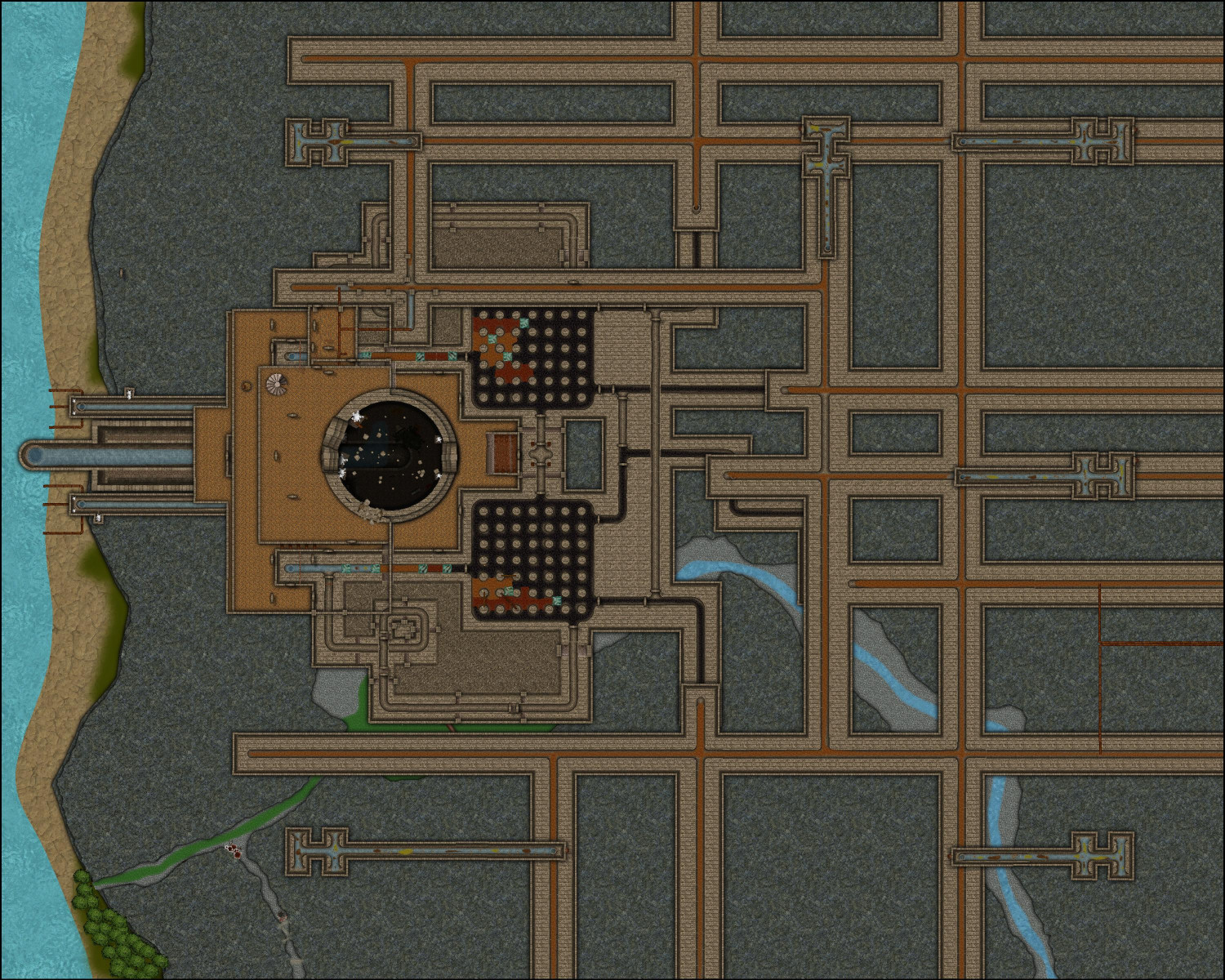[WIP] The Sewers of Elmsbrook Township
These are the sewers for Elmsbrook, a town in the human kingdom of Powys in my campaign world. They’re intended to be fairly representative on the sewer systems in my kingdom – smaller villages might have a simpler system, but larger cities will have the same basic layout, but with more extensive canals.
I was hoping to get this done the same month that Sinister Sewers was released, and I barely did it. I still have work to do, and advice to collect, but thought I would post where this stands.
By the way, Sue: it worked putting everything for each level on its own layer, making it easy to display or hide different levels as needed.
In addition to using the symbols and fills from Sinister Sewers, this also uses a few things from Marine Dungeons (particularly the stairs and the bell at the bottom of the pit), and a few things from Forest Trails (leaves, the trees along the beach, and maybe some of the fills) and Creepy Crypts. Also: Sue spent a lot of time helping me come up with a technique to show clear water, but it really worked best close-up. At this scale, it made it look like black water. I ended up using a water fill from Creepy Crypts, but on its own water sheet with a 50% transparency effect added.
In my campaign world, fastidious elves have long understood at a high level the correlation between hygiene, sanitation, and the spread of diseases. (Even if they don’t have the tools to study microbiology and virology, they can study commonalities in infected populations to identify vectors of disease.) Dwarves first developed aqueducts and sewer technology. And it is said that orcs pioneered the use of flesh-eating oozes for waste management.
Oozes are amorphous creatures with an intelligence no greater than an ordinary garden slug, flowing through subterranean lairs to devour any creature or object they can dissolve while shunning things that provoke their flight reflex, like bright lights and extreme temperatures. I have made a few tweaks to oozes in my campaign world to make them better suited for deploying in sewers. I added immunity to poison and diseases. I also added a weakness: sunlight hypersensitivity where, like vampires, they can be damaged by exposure to sunlight. (This is why they avoid bright lights: a bright lantern won’t harm them, but it still triggers their flight reflex.) Sunlight can kill an ooze, causing their acids to neutralize and their bodily remains to collapse into a nutrient-rich goo that farmers often use to fertilize their crops.
Some items of note about specific oozes used in sanitation systems. Gelatinous Cubes can dissolve nonmagical soft tissue and vegetation, leaving behind undissolved bones, metal, glass, stone, and magical items of any sort, along with excess water stripped of anything edible. They cannot climb but can move up slopes with a grade of 25 degrees or less. Moving up a slope with a grade of 10 degrees or more requires the Cube to expel any indigestible materials or excess water. Black Puddings are far more dangerous. In addition to dissolving soft tissue and vegetation, they can also dissolve nonmagical bones, metal, but cannot dissolve glass, stone, or magical items. They can also climb any surface, even upside down. Sanitation workers employ bright lights to keep Black Puddings from escaping (and an ample food supply keeps them from seeking to escape). And finally, I created a new ooze called a Voracious Sullage. It’s a slow-moving, weaker version of the Gelatinous Cube, unable to maintain a cubic shape. It tends to stretch itself across small waterways so that anything edible flows to it (and anything it can’t eat gets expelled on the other side).
Here's a quick summary of how the sanitation system works. More specifics for each level of the sewer system will follow in the comments.
Surface (not shown): Storm drains at the intersections of major streets, with a manhole cover at one of the corners than allows maintenance workers to descend using rungs. There is also a large Waste Management Facility where residents can dispose of large objects that cannot be repaired or repurposed (such as items that cannot be chopped up for kindling). Maintenance workers throw these items into a giant pit nicknamed the Great Maw that is about 140 feet in diameter. The surface of this pit is in a building that is covered at night but open to the sky during the day. Bright luminescent crystals are placed near the mouth of the pit to frighten away the Black Pudding at the bottom of the pit.
Level 1: This level is immediately below the surface. Storm drains at major intersections deposit rainwater (along with other debris) here, where they run off to chutes that bring wastewater to Level 2.
Level 2: Wastewater from Level 1 is deposited here, where it helps push through human waste from outhouses and latrines that are connected to the sewer system. This sewage flows through chutes down to Level 3.
Level 3: Waste brought in from Levels 1 and 2 are treated here in two great chambers called Auditoriums. Numerous Gelatinous Cubes gobble up the waste, leaving behind items they cannot digest, and now-clean water stripped of contaminants. This purified water drops through chutes to Level 4.
Level 4: Primarily a passthrough level, and the lowest level that maintenance workers normally go.
Level 5: A Black Pudding lives at the base on the Great Maw, devouring any waste thrown into the pit. It can eat nonmagical flesh, vegetation, and metal, but cannot digest stone, glass, or magical objects of any sort. Water purified in Level 3 descends to this level, where some passes directly to the sea and the rest is used to flush out anything the Black Pudding cannot digest.
More details for each level in the comments.








Comments
Level 1 primarily collects water from storm drains along with leaves and vegetation that might get swept in. Manure from horses on the street and domesticated animals are often shoveled into these storm drains as well. These drain into chutes that flow into Level 2.
Maintenance workers can enter this level through a staircase near the Great Maw that descends to a maintenance room, where a great seat of stone doors allows them to dump refuse into the giant pit. Luminescent crystals on the pit side of these great doors helps keep the Black Pudding from ascending this far. A spiral staircase in this room ascends to the surface and descends to Level 2.
Each intersection that has a stormwater drain also has a manhole that allows maintenance workers to climb down. These storm drains do not connect to one another, and maintenance workers who want to traverse the system will have to continue down ladders to Level 2.
Still to come: I want to work on the labels more, and I may add some of the rocky texture to outline the storm drains.
Although some outhouses and latrines are closed systems, some connect to canal drains in Level 2 of the town’s sewers. Stormwater drains from Level 1 help keep things flowing, but water from the town’s aqueducts is needed to supplement during dry weather. This level has wider walkways to make it easier for maintenance workers to address blockages and other problems.
Waste from here flows through chutes to Level 3.
Still to come: I may add some of the rocky texture to outline the canal drains on this level.
In Level 3, waste from the upper levels is purified through the strategic use of Gelatinous Cubes.
This level has the “nerve center” for the maintenance workers, where a number of wheel gate valves can be used to open or shut doorways in the canal drains, allowing portions of the treatment center to be closed off as needed, redirecting waste to open areas of the level.
Waste flows down to two great rooms, called Filtration Auditoriums. There, several Gelatinous Cubes gobble up as much of the waste as they can eat. The remaining waste flows through the Waste Filtration Path, where a series of grates keep four Gelatinous Cubes isolated. As oozes can slip through openings as small as an inch, these have been constructed to have mesh holes smaller than a quarter of an inch – small enough to allow water to flow through while keeping the Gelatinous Cubes contained, happily gobbling up a steady supply of food.
Wastewater flows through each Gelatinous Cube, becoming progressively more purified.
Each day, a passageway at the end of the Waste Filtration Path is opened, allowing the Cube at the end to crawl up a sloped path back to the Filtration Auditorium. (The stairs from Marine Dungeons help show how it slopes, and I included a spiral in the canal to show that as well.) As the Cube climbs the slope, it releases any indigestible objects along with now-purified water. Maintenance workers will then collect any coins or other valuables before tossing any remaining refuse into the Great Maw.
If a Filtration Auditorium needs to be closed (to retrieve a valuable object or for repair), there are two bypass lanes (one flowing down to the northern chamber, the other flowing down to the southern chamber) that can be opened as needed so that waste flows to the still-open auditorium. In addition, a passage that slopes up to the center and then back down to the other chamber connects the two chambers, allowing Gelatinous Cubes to be herded with bright lights to the other chamber.
QUESTIONS: I used Effluent 5 to show the most polluted sewage, and then down to Effluence 4 and then Effluent 3 as it was cleaned up. I then used the Water fill with varying levels of scum on top to show the water getting progressively cleaned. The more I look at Effluents 4 and 5, the more I’m wondering if I am using them as intended. Effluent 4 has a reddish hue – was it meant to be blood? And Effluent 5 is practically black. Is it meant to be some sort of demonic ichor or a necromancer’s waste? I’m wondering if it would be better for me to use Effluent 3 for the waste, and then the water fill with decreasing amounts of scum to show the water being cleaned?
Still to come: I might need to add some arrows to show how things flow, and maybe more doors if certain areas need to be able to be bypassed. And more rocky terrain texture surrounding everything.
Level 4 is the lowest level that maintenance workers generally go, though a stone door provides emergency access to Level 5 as needed. (Just realized I haven’t built that part yet.) Purified water from Level 3 flows through here. Luminescent Crystals are used to help keep the Black Pudding at bay. There is no access to the Great Maw from this level.
(I just noticed that this looks vaguely like the Starship Enterprise.)
In Level 5, purified water from Level 4 hits at a high spot that slopes both to the west and to the east. Water that flows to the west will reach the end of the canal and be deposited into water pipes that take it out to sea. Water that flows east will end up in a supersized drainage canal to help carry refuse from the bottom of the Great Maw.
The Great Maw ends at this level. All manner of waste digestible by the Black Pudding is tossed in here, including unusable metal and wooden objects, as well as any bones picked clean by the Gelatinous Cubes in Level 3. Here, the Black Pudding is munching on a great bell that has been thrown away, as well as some broken furniture. (Yeah, townfolk would probably chop up the broken furniture for firewood, but I wanted to show the Pudding eating metal and wood.) Left untouched for daring adventurers: a ceramic urn and a stone statue that are indigestible, along with some glass bottles. There’s also a staff, book, and scroll case that should be edible…unless they’re magical.
An extra large canal brings any remaining wastewater to the sea. Here, a Voracious Sullage has stretched itself across the canal, holding on to two side pillars as it scoops up anything edible remaining in the water.
A portion of the Great Maw’s wall has broken down, revealing a few caverns that are home to a strange tentacle aberration.
If adventurers survive the Black Pudding, the tentacle aberration, and the carnivorous plants down the passageway, they might find an escape route through the southern passage. But they might not be home free: something got the last adventurers who rested here (though that something might have been carbon monoxide poisoning if they lit a campfire in this poorly ventilated space).
Very inventive, and a nice use of combined styles :)
I tweaked it to change the effluent on Level 3 to Effluent o3, then changed it after the first Gelatinous Cube in the Waste Filtration Path to clear water with decreasing amounts of scum as it gets purified. Added some clear water near the cubes in the Filtration Auditoriums to show that they ate some of the contaminants as they were traveling through. Also added some floor stains.
I think this makes it a bit clearer that the Gelatinous Cubes are consuming the waste and purifying the water. I will go through add more scum to the floors and the effluent in Levels 2 and 3.
Okay. This. Is. Bloody. Brilliant. Love it. Really inventive and artistic at the same time. I would freaking LOVE if you could find a place for this in our atlas 😁
Oh my goodness, thank you! I'm so new here, I keep seeing things about the Atlas and figured I would read up on it once I felt more up to speed. I will start looking into it.
Realized I should close the circle here. I designed the town above these sewers, which you can see in this thread as well as this gallery of larger images.